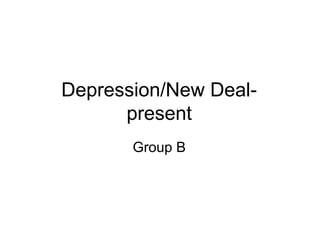
Day 7 question copy
- 1. Depression/New Deal- present Group B
- 2. The Question • To what extent did the decade of the 1950’s deserve its reputation as an age of political, social, and cultural conformity?
- 3. The Thesis • The 1950’s greatly deserves its reputation as a decade of conformity. With the horrors of communism still fresh in everyone’s mind, Americans were eager to return to their roots and prove that the American way of life was the best way to live.
- 4. The Red Scare • Everyone was anti communism • Started by Republican Senator McCarthy who was largely anticommunism • Many politicians had to swear that they were not communists when they would take oaths of office (Truman’s loyalty program)
- 5. Communism • Huge scare of communism after WWII • Cold War with the concept of MAD firmly established (MAD= mutually assured destruction) • Ike and Brinksmanship – goal= destruction as opposed to Truman’s containment policy – go in with all out war against communism – this idea failed with the Hungarian uprising where the policy proved to be too heavy5to5
- 6. US involved abroad • Eisenhower Doctrine pledges support to smaller nations fighting communism • U2 incident sparks tension between US and SU • CIA bribes people in Iran to accept Shah to control/secure US oil interests – turning point from US being the #1 oil exporter to the #1 oil importer • Vietnam – North is communist (HO Chih Minh)and South is democratic (Ngo Dinh Diem) – Hold election to decide whether Vietnam would be unified under communism to democracy (never held) – Geneva Accords give everything south of the 17th parallel to 6 6 France
- 7. Social/Cultural • Everyone was so scared of communism that they wanted to act very American so everyone conformed to what they called the “American Dream” • The growing middle class • By the end of the 50’s most had a TV • TV would show the “perfect suburban life” – husband as breadwinner, wife as stay-at-home mom • Stronger sense of consumerism – Computer is invented!! – Cars and stuff (in general) became sought after
- 8. Social/Cultural continued • Return of the cult of domesticity – with the end of WWII women left the work place to return home and raise children – baby boomer’s generation • Creation of Levittowns/suburbia – the more economically sound middle class moved out of the cities to Levittowns which were cookie cutter neighborhoods • this movement of the white middle class out of the cities made it difficult to segregate schools without 8 8 extensive busing
- 9. Cultural • Clark’s finding that segregation had a detrimental psychological effect on black children – this case was cited in the Brown case • Brown vs. Board of Education declared “separate but equal” unconstitutional (violation of the 14th amendment) • Boycott of the buses by African Americans along with a new wave of civil rights activists • The Southern Manifesto (1956) – accused the Supreme Court of “clear abuse of judicial power” – reaction by Dixiecrats to the Brown decision – Strom Thurmond (who would later run for president) wrote it 9 9
- 10. Cultural • Clark’s finding that segregation had a detrimental psychological effect on black children – this case was cited in the Brown case • Brown vs. Board of Education declared “separate but equal” unconstitutional (violation of the 14th amendment) • Boycott of the buses by African Americans along with a new wave of civil rights activists • The Southern Manifesto (1956) – accused the Supreme Court of “clear abuse of judicial power” – reaction by Dixiecrats to the Brown decision – Strom Thurmond (who would later run for president) wrote it 9 9